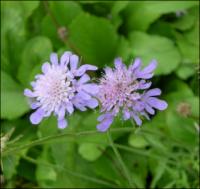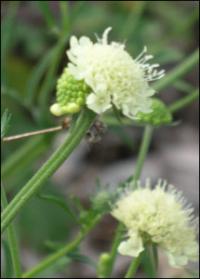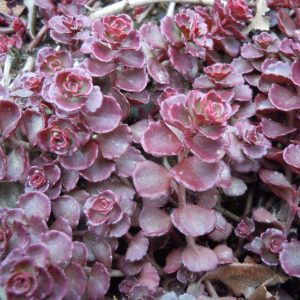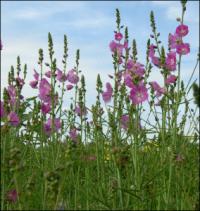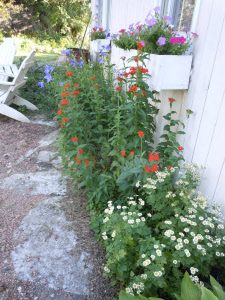Drought, Xeric & Dry Soil Plants
Showing 105–112 of 126 results
-
Scabiosa lucida Pincushion flower Z 4-9
Lilac pincushions all summer & fall
OUT OF STOCK
Lilac pincushions all summer & fall, non-stop
Size: 24" x 12"
Care: full sun in well-drained soil.
Native: Central and Eastern Europe
Wildlife Value: attracts butterfliesScabiosa from Latin scabies referring to the itch caused by a mite infestation, which another Scabiosa species allegedly cured. This species 1st described in a French publication in 1779.
-
Scabiosa ochroleuca Cream pincushion Z 4-9
Looking for a non-stop bloomer? Cream petals compacted together bloom atop tall, wiry stems from June to October
Looking for a non-stop bloomer? Cream petals compacted together bloom atop tall, wiry stems from June to October
Size: 18"-24" x 18"
Care: sun to part shade in moist well-drained soil. Drought tolerant.
Native: Europe & Asia
Wildlife Value: attracts butterfliesThe name scabiosa from Latin scabies refers to the mite infestation that this plant was supposed to cure; ochroleuca means “yellowish white.” First described by Swiss botanist Bauhin Caspar (1560-1642) in Pinax theatri botanici in 1623.
-
Schizachyrium scoparium syn. Andropogon scoparium Little bluestem Z 3-9
Wispy, feather-like seedheads atop blue-grey foliage that turns plum-orange-red in fall.
Wispy, feather-like seedheads atop blue-grey foliage that turns plum-orange-red in fall
Size: 18" x 12"
Care: sun in well-drained soil.
Native: all No. America, Wisconsin native.
Wildlife Value: leaves are food for Skipper butterfly caterpillars and seeds food for songbirdsComanche used it to remedy syphilitic sores. Lakota made soft, wispy seedheads into liners for moccasins. Collected by French plant hunter André Michaux (1746-1802) in America’s prairies c. 1790
-
Sedum spurium ‘Dragon’s Blood’ syn. Phedimus spurius ‘Dragon’s Blood’ Caucasian stonecrop Z 4-9
Mat-forming evergreen. In spring red encircle its fleshy, green, round leaves. In summer leaves turn bronze and in fall deep burgundy. Small, bright pink, star-shaped flowers.
Mat-forming evergreen. In spring red encircle its fleshy, green, round leaves. In summer leaves turn bronze and in fall deep burgundy. Small, bright pink, star-shaped flowers.
Size: 4-6" x spreading 12-18"
Care: sun in well-drained to moist well-drained soil
Native: Caucasus Mountains
Awards: Royal Horticultural Society Award of Garden Merit; Great Plant PickFranklin Gardens in Big Springs Arkansas sold this in 1948 for 50 cents calling it “a new sedum. . . “Called “a new Sedum that will surely become popular” New and Noteworthy Hardy Plants Spring Flor-Acres’ Perennials 1950 p. 13
-
Sesleria autumnalis Autumn Moor Grass Z 5-9
Fresh-green spring narrow blades of grass in summer add airy purplish flower spikes with silver-white stamens on this low mounding, arching grass. Blades have a striking yellow-green color that sometimes develops a soothing golden autumn tint. Spike-like silvery flowers rise above the leaves and mature into soft tan seed heads by autumn.
Fresh-green spring narrow blades of grass in summer add airy purplish flower spikes with silver-white stamens on this low mounding, arching grass. Blades have a striking yellow-green color that sometimes develops a soothing golden autumn tint. Spike-like silvery flowers rise above the leaves and mature into soft tan seed heads by autumn.
Size: 16-18” x 12-18”
Care: sun to part shade in moist well-drained to well-drained soil, drought tolerant
Native: SE Europe east to Caucusus
Wildlife Value: walnut, salt and deer tolerant
Awards: Royal Horticultural Society Award of Garden Merit. Gardens Illustrated “100 Must-Have Garden Plants,” 2013.Collected in Slovenian mountains near Idria, c. 1760 by and 1st described in Flora Carniolica by Giovanni Antonio Scopoli (1723-1788) physician, naturalist and author. Sesleria is named to honor Leonardo Selser, 18th century Italian botanist and physician, contemporary and likely friend of Scopoli
-
Sidalcea malvaeflora Checker bloom Z 5-9
Bright pink mallow type blooms looking like a miniature hollyhock.
Bright pink mallow type blooms looking like miniature hollyhock.
Size: 2-3' x 10"
Care: sun to part shade in well-drained soil
Native: western No. America
Wildlife Value: Attracts large white skipper butterflies.Sidalcea is the conjunction of sida and alcea. Collected by Mexican botanist José Moziño around 1790 while on the Expedición Real de Botánica, probably in today’s Southern California.
-
Silene chalcedonica syn. Lychnis chalcedonica Maltese cross, Jerusalem cross Z 4-8
Early and midsummer, blood-colored heads made of clusters of flowers each with petals like spokes of a wheel with edges curved down. Blooms in summer.
Early and midsummer, blood-colored heads made of clusters of flowers each with petals like spokes of a wheel with edges curved down. Blooms in summer.
Size: 3-4' x 12"
Care: Sun to part shade, moderately fertile, well-drained soil. Will repeat bloom if deadheaded.
Native: Western Russia
Awards: England’s Royal Horticultural Society Award of Merit.Lychnis named by Theophrastus in the 3rd century B.C. for “lamp” (lychnos) due to using the leaves of Lychnis coronaria for lamp wicks, but some say due to the flame-colored flowers. Chalcedonica refers to Chalcedon, a district near Constantinople. Louis IX reputedly transported this plant from Jerusalem to France on his return from the Crusades. By 1597 it was “very common everywhere” in England. In 1912 Liberty Hyde Bailey called this “one of the best of old-fashioned flowers.” Grown by both Washington and Jefferson.
-
Silene coronaria syn. Lychnis coronaria Rose campion Z 4-8
Bright crimson/magenta 5-round-petaled flowers contrast felted silvery-white foliage in early to midsummer. Be sure to let it drop its seeds for more plants next year or the year after.
Bright crimson/magenta 5-round-petaled flowers contrast felted silvery-white foliage in early to midsummer. Be sure to let it drop its seeds for more plants next year or the year after.
Size: 24" x 18"
Care: Full sun in moist well-drained to well-drained soil
Native: Southeastern Europe
Awards: England's Royal Horticultural Society Award of Merit.Lychnis named by Theophrastus in the 3rd century B.C. for “lamp” believed to be because the downy leaves were used to make lamp wicks, but some say due to the flame-colored flowers. Mythology reports that the Rose campion sprang from the bath of Aphrodite. Rose campion has been in European garden cultivation since the 1300’s. Parkinson in 1629 wrote of the Rose campion: “The single red Rose campion hath divers thick, hoary or woolly long greene leaves, abiding greene all the winter, and in the end of the spring or beginning of summer, shooteth forth two or three hard round woolly stalkes, with some joints thereon, and as every joint two such like hoary greene leaves as those below, but smaller, diversly branched at the toppe, having one flower upon each severall long stalke … of a perfect red crimson colour …” Paradisi in Sole Paradisus Terrestris. Both George Washington and Thomas Jefferson grew this plant. (Jefferson in 1807.)

